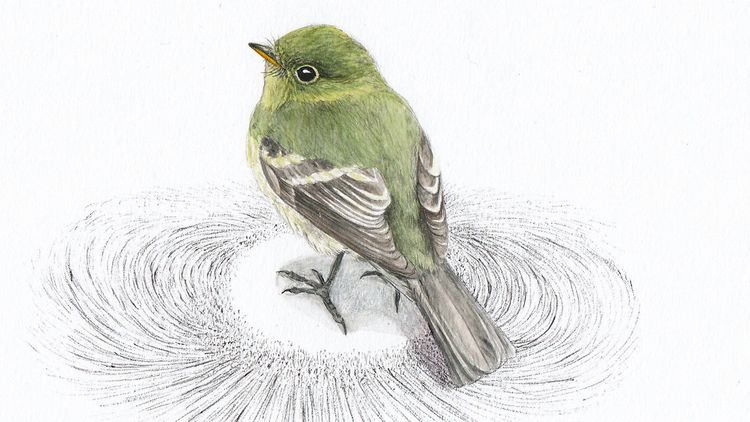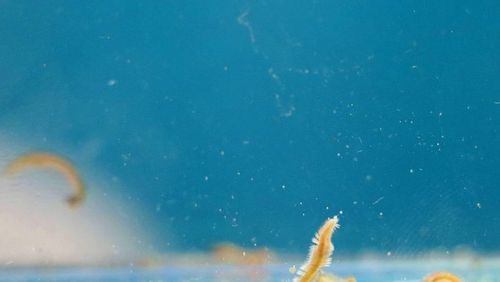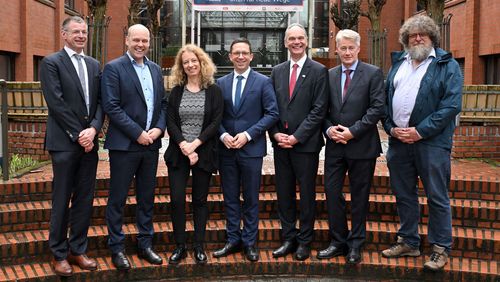The magnetic sense of migratory birds is probably based on a special protein – this theory is supported by a new genetic study. A research team from the University of Oldenburg and the Institute of Avian Research found that the protein has been optimised through rapid selection.
Migratory birds are able to navigate and orientate with astonishing accuracy using various mechanisms including a magnetic compass. A team led by biologists Dr Corinna Langebrake and Prof. Dr. Miriam Liedvogel from the University of Oldenburg and the Institute of Avian Research “Vogelwarte Helgoland” in Wilhelmshaven has now compared the genomes of several hundred bird species and found further evidence that a specific protein in the birds’ eyes is the magnetoreceptor which underlies this process.
The researchers found that there have been significant evolutionary changes in the gene that encodes the protein cryptochrome 4, and that certain groups of birds have lost it entirely. These findings are indicative of adaptation to varying environmental conditions and support the theory that cryptochrome 4 functions as a sensor protein, as the team reports in a newly published paper in the British Royal Society research journal Proceedings B.
The study was prompted by research at the Universities of Oldenburg and Oxford (UK) which has shown that magnetoreception is based on a complex quantum mechanical process that takes place in certain cells in the retinas of migratory birds. In a paper published in the science journal Nature in 2021, the German-British team presented findings according to which it was highly likely that cryptochrome 4 was the magnetoreceptor they had been looking for: first, they were able to prove that the protein is present in the birds’ retina, and second, both experiments with bacterially produced proteins and model calculations showed that cryptochrome 4 exhibits the suspected quantum effect in response to magnetic fields.
Robin’s proteins are significantly more sensitive to magnetic fields than that of chickens
Interestingly, the research also demonstrated that these proteins are significantly more sensitive to magnetic fields in robins, which are migratory birds, than in chickens and pigeons, which are resident species. “Consequently, the reason why cryptochrome 4 is more sensitive in robins than in chickens and pigeons must be found in the protein’s DNA sequence,” says Langebrake, who was the lead author. “The sequence was probably optimised by evolutionary processes in these nocturnal migratory birds,” she adds.
In the current study, the team led by Langebrake and Liedvogel therefore investigated magnetoreception from an evolutionary perspective for the first time. The researchers analysed the cryptochrome 4 genes of 363 bird species ranging from the little spotted kiwi to the song sparrow. First, they compared the protein’s evolutionary rate with that of two related cryptochromes, and found that the gene sequences of the cryptochromes used for comparison were very similar across all bird species: They appear to have changed very little over the course of evolution. This is most likely due to their key role in regulating the internal clock – a mechanism that is essential for all birds and in which modifications would have extremely negative effects.
Cryptochrome 4, by contrast, proved to have been highly variable. “This suggests that the protein is important for adaptation to specific environmental conditions,” explains Liedvogel, who is Professor of Ornithology at the University of Oldenburg and director of the Institute of Avian Research. The resulting specialisation could be magnetoreception. “A similar pattern has been observed in other sensory proteins such as light-sensitive pigments in the eye,” she explains.
Optimised through rapid selection
The researchers then took a closer look at how the gene sequence for chryptochrome 4 has evolved in the evolutionary history of birds. The results led the scientists to conclude that in particular in the case of the passerine (Passeriformes) order the protein has been optimised through rapid selection. “Our results indicate that evolutionary processes could have led to cryptochrome 4 specialising as a magnetoreceptor in songbirds,” says Langebrake.
Another interesting finding was that in three clades of tropical birds – parrots, hummingbirds and Tyranni (Suboscines), also known as tyrants – the information for cryptochrome 4 has been lost in the evolutionary process, meaning that these birds are unable to produce the protein. This indicates that it does not play a vital role in their survival. However, while parrots and hummingbirds are sedentary, some tyrants are long-distance migrants which, like small European songbirds, fly both during the day and at night. “The fact that, unlike robins, they do not have cryptochrome 4 makes them an ideal system for investigating various hypotheses about magnetoreception,” says Langebrake.
An interesting question here is: have the Tyranni developed a magnetic sense that works independently of cryptochrome 4? Or are they able to orientate themselves without a magnetic sense? Another possibility is that their magnetic sense has the same characteristics as that in robins, which is light-dependent and can be disrupted by radio waves, for example. “The first two scenarios would strongly corroborate the cryptochrome 4 hypothesis, while the third would pose a problem for the theory,” the biologist emphasises.
A natural tool for understanding magnetoreception
As a next step the research team is therefore planning to investigate magnetic orientation in Tyranni, and clarify whether or not they have a magnetic sense. “The Tyranni clade provides us with a natural tool for understanding the function of cryptochrome 4 and the importance of magnetoreception in migratory birds,” says Liedvogel, outlining a starting point for further research.
This genetic study is a result of the Collaborative Research Centre Magnetoreception and Navigation in Vertebrates: From Biophysics to Brain and Behaviour”, which is headed by biologist Prof. Dr. Henrik Mouritsen from the University of Oldenburg and in which the Institute of Avian Research is also involved. Researchers from the Max Planck Institute for Evolutionary Biology in Plön also contributed to the current study.






